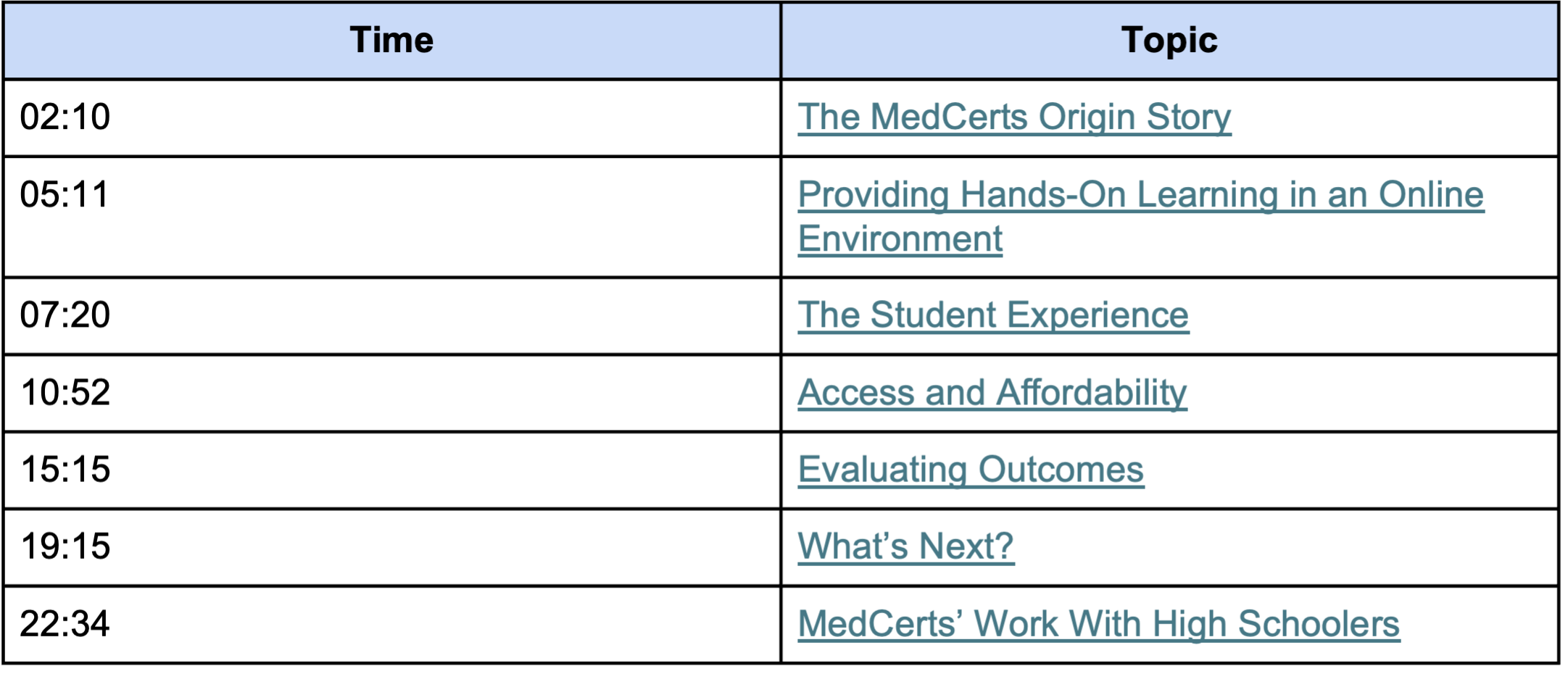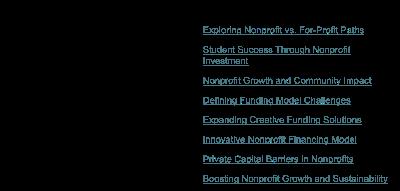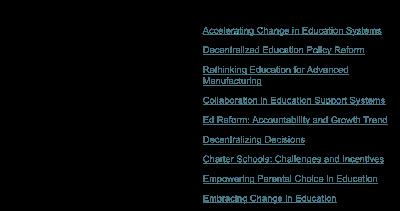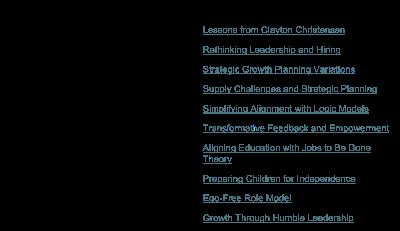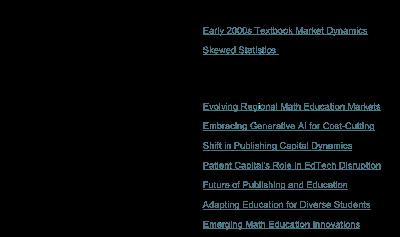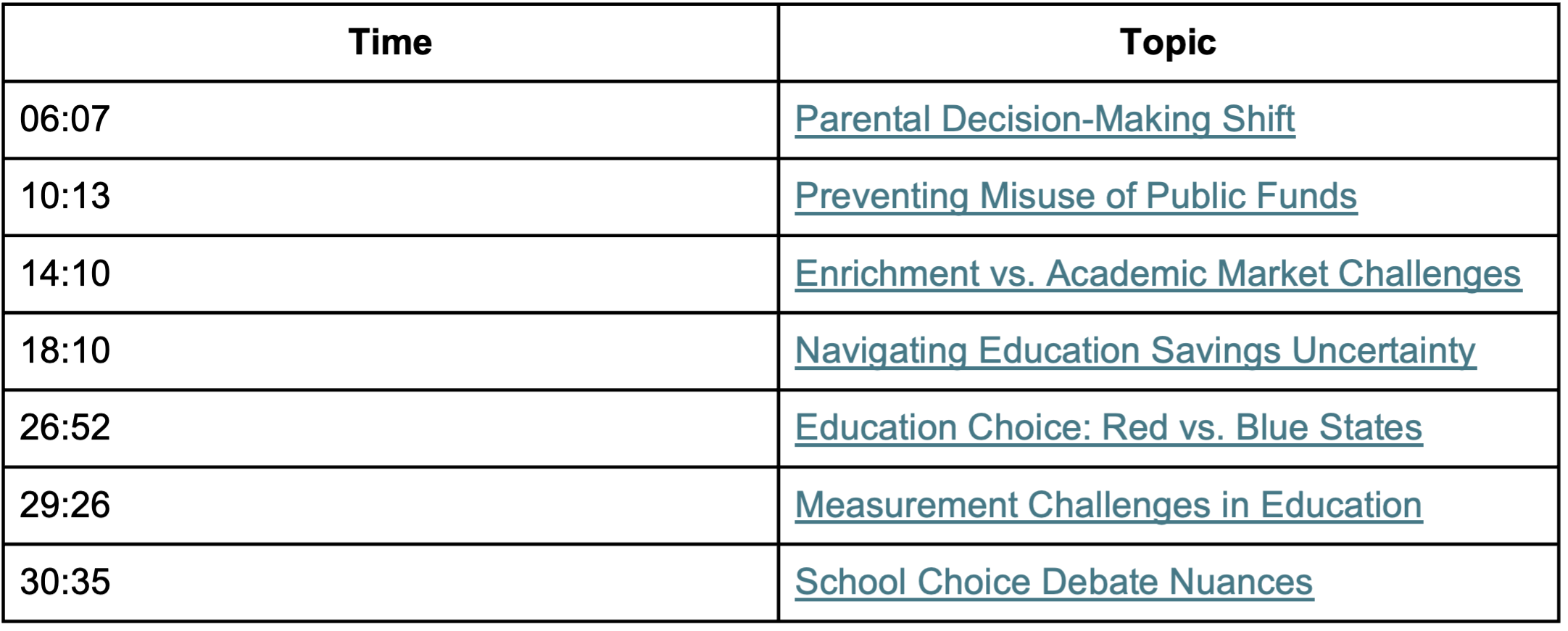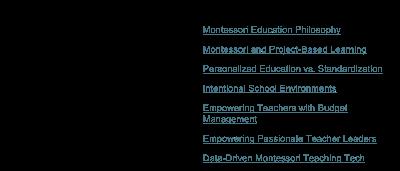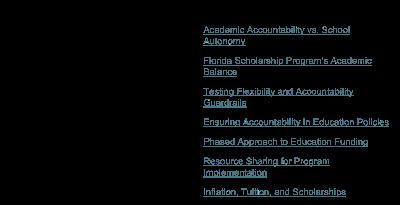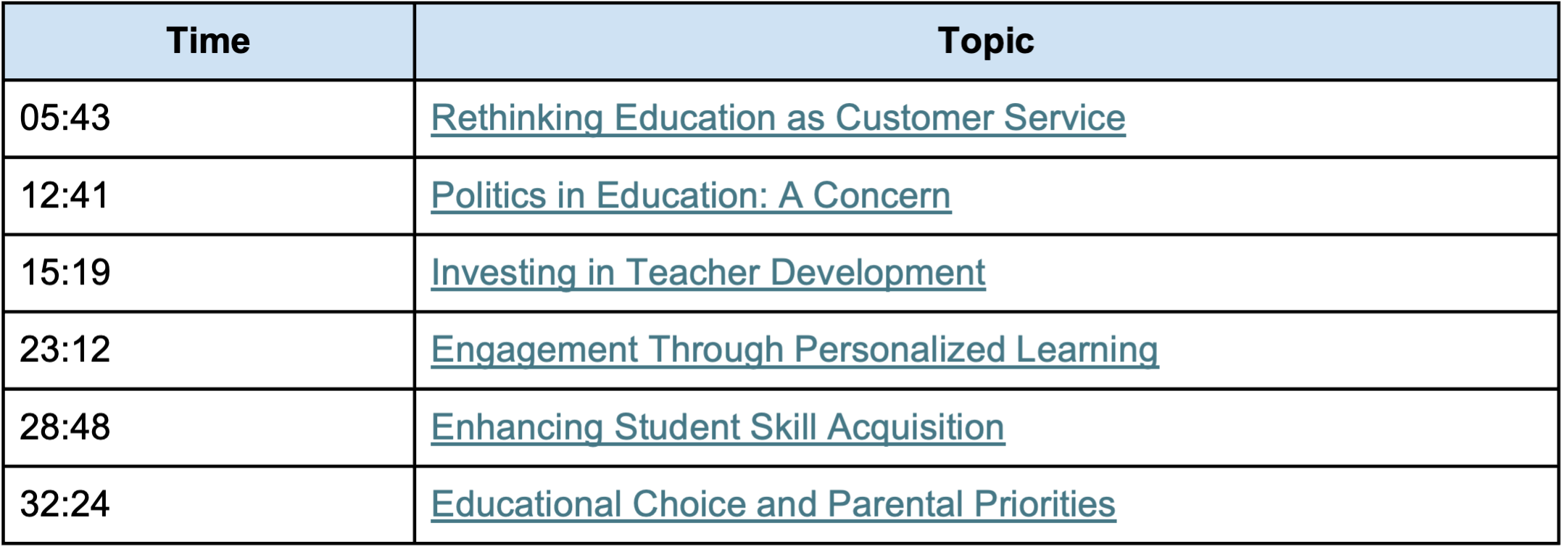A Disruptive Approach to Training Health-Care Talent
Description
In this latest episode, I got to join forces with my colleague Ann Somers Hogg, who leads health-care research at the Christensen Institute and hosts the podcast, Life-Centered Health Care. Our guest was Craig Sprinkle, CEO of MedCerts. We discuss how MedCerts trains health-care professionals, from how it delivers hands-on learning through remote instruction to the savings students have incurred and future innovations on the horizon.
Michael Horn:
Welcome, everyone. Michael Horn here. And I'm thrilled for today's episode of our podcast, which will be different from what we've done in the past. And that's because we're doing a joint podcast, if you will, so that this episode will actually air in two different places. There's, of course, my podcast, the Future of Education, where we're dedicated to building a world in which all individuals can build their passions, fulfill their potential, and live a life of purpose. And then we're partnering today with Life-Centered Health Care, a podcast that my colleague at the Christensen Institute, Ann Somers Hogg, produces. And Life-Centered Health Care delves into what disrupting health care really means. Not the buzz phrase, but what does it really look like and how do we do it? And how do the innovation theories that we use at the Clayton Christensen Institute shed light on the evolution of the broader health-care ecosystem to inspire others seeking to transform health care? So first, a welcome to my co-host for today. She's a senior research fellow at the Christensen Institute, Ann Somers. So good to see you. Happy New Year.
Ann Somers Hogg:
Great to see you. Happy New Year. Thank you for having me today. I'm excited about this.
Michael Horn:
Yeah, absolutely. I'm glad we're teaming up together on this. And for those wondering why we're doing a joint podcast, I will say the reason is because those who fill the jobs in health care, of course, do so through forms of medical education. And that's a place in sore need of innovation itself as we think about that broader ecosystem. So with that, I'll introduce our guest for today who's going to shed light on all this. Craig Sprinkle, CEO of MedCerts since 2022, you're an InStride company. And of course, Craig joined MedCerts in 2018 in a combined role as the CFO and COO and has served as the CFO since 2020 before stepping into the CEO role. So, Craig, great to see you. Thank you for joining us.
Craig Sprinkle:
Yes, thank you for having me. I'm really happy to be here. So thank you. Great to see both of you.
The MedCerts Origin Story
Michael Horn:
Yeah, you bet. So I want to start actually, you know, predating you at MedCerts, but what led to the launch of MedCerts, You know, what's the market need you all were fulfilling and the credentials that you're really helping fill in the health-care system. I will say, like, I had the chance to watch some of the formation of it, but I've never actually heard from someone at MedCerts how they view the opportunity and market need
Craig Sprinkle:
Yeah, absolutely, so as you said, it kind of predates me a little bit, but I'm happy to share that. First of all, we just celebrated our 15-year anniversary a year ago. MedCerts originally was founded and frankly still operates very similarly today, in a way that we saw a lack of quality online health-care training that existed 15 years ago that would quickly elevate students to be able to gain new skills, be job ready, and be ready to step into a job or a career. So we saw that gap, we saw an opportunity to ultimately fulfill that. At the same time. And what still carries forward today is that we're addressing a skills gap in the health care and IT industry. Employer needs are continuing to grow. They're looking for more out of job candidates and people that they want to fill vacancies that they have. And there's just a lack of available talent. So we saw a need not only in terms of delivery of that curriculum and delivery of that education, but also fulfilling a need on the employer side to really train towards skills that employers are looking for and making sure that those students are ultimately job ready when they come out of that training.
Ann Somers Hogg:
Yeah, you mentioned that there was a lack of quality online medical training. Could you tell us a little bit about how do you compare with other market offerings in terms of thinking about your business model? So what are the resources and processes that you have in place to educate your learners?
Craig Sprinkle:
Yeah, absolutely. I mean, I know that we'll probably talk a little bit more about delivery models and things like that as we continue the conversation, but if you kind of rewind 15 years ago, you know, a lot of things that the experience that a student would have is mostly like in classroom instruction, there wasn't a lot of hands on experience being taught. There wasn't a lot of applicable skills being taught inside that classroom experience. And that was ultimately leading to a gap whenever a person would walk out of that training to ultimately be ready to step into a job. We saw that, and I don't think that it was perfect at the time 15 years ago, whenever we first started delivering this, but bringing more of those applicable skills into an application environment where the student is not only listening to instruction on screen, but they're also learning on how to apply those skills as they're learning and going through that training. So that's a little bit of the difference, if you will, between the delivery of something that we were doing at the time online versus more traditional in classroom instruction. Not as much hands-on experience and not as much interactivity, if you will, within the classroom itself.
Providing Hands-On Learning in an Online Environment
Ann Somers Hogg:
Got it, got it. Thanks for explaining that. And this is probably going to sound like a silly question, but I want to dive into it because if it's an online based education program. You mentioned the importance of the hands-on training and a lot of medical training involves that hands-on experience. So how do you provide these hands-on learning opportunities for students in that online environment?
Craig Sprinkle:
Yeah, absolutely. So a lot of our programs first and foremost involve a clinical requirement. So there is hands-on training required in order to even obtain the credential to begin with, in many of the programs that we train towards. The way that we accomplish that is a couple of different ways. One, we have a lot of partnerships with employers whereby they have agreed to allow our students to come on site, in their environment, work alongside someone else and ultimately obtain those skills. So they're not only taking what they've learned in classroom, if you will, through our didactic portion of our training, but also taking that into a live environment and applying it alongside someone that's already working in the job or the role that they're ultimately seeking to be a part of. So some of that is through those relationships that we have. We also work with a lot of local training facilities that ultimately host students to allow them to come into a simulated classroom environment, or, sorry, a work environment to where they can do the same thing, it's just not on site with a particular employer. So we do that in both ways. We do it through partnerships that we have with employers. Then we also do that through training sites that we have relationships with, whether that's regionally or locally based, to where our students can go into those facilities and ultimately complete those clinical requirements and hands-on requirements that they have. The third element of that is that we also have skill assessments built into our training itself online. So as the student goes out on site, they get some of that hands-on experience, they come back, if you will, into the virtual classroom. We have assessments that we will walk a student through to ultimately test their proficiency on how well they understood some of those things that they learned. And they're going through assessments on a regular basis and getting feedback on areas where they can and need to improve.
The Student Experience
Michael Horn:
It's super interesting to hear you sort of break that down, Craig, because what is coming across actually is that you weren't just innovating in the area of online education, but you were also innovating against the traditional model, as you described, to create a much more interactive experience, a more active learning experience it sounds like. Just talk us through what a typical student experience looks like over the course of their certification program. But also maybe Ann Somers, we can ask the question about business model in terms of program costs relative to other options in a moment but Craig, just focus on like the interactive learning experience itself and how that differs and how you facilitated that over the course of their certification.
Craig Sprinkle:
Yeah, sure, absolutely. And I guess I'll preface this by saying that obviously every student experience is a little bit different. But by and large, when a student first enrolls in their program, first and foremost they're looking for that alternative route in order to get a fast track into a career. That's sort of fundamental to what we do, is that we offer that affordable training. It's something that we can offer in a fast and rapid way fo

